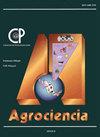ANALYSIS OF THE SPATIAL ASSOCIATION OF FUMAGINA (Capnodium spp.) AND GREEN SCALE (Coccus viridis) IN COFFEE IN SULTEPEC, MEXICO
IF 0.5
4区 农林科学
Q4 AGRICULTURE, MULTIDISCIPLINARY
引用次数: 0
Abstract
The coffee crop (Coffea arabica L.) presents phytosanitary problems that can be economically significant if not properly managed, such as green scale (Coccus viridis) and fumagina (Capnodium spp.). Geostatistics is a tool that allows the producer to make optimal, timely, and accurate decisions for the integrated management of these problems. The objective of the research was to analyze the distribution and spatial association of fumagina and green scale in the coffee crop in Sultepec, State of Mexico, Mexico. During the first semester of 2022, random coffee plots were marked and geo-referenced for sampling. Several methods were used to obtain the spatial distribution of fumagina and green scale. The results showed fits of Gaussian, exponential, and mostly spherical geostatistical models, which represent an aggregate distribution and an association of these problems with each other. The estimation of the infested and infected area for both problems was obtained using the ordinary kriging method, revealing the presence of foci of infection and infestation. In plot three, it was identified that these are maintained and increase as the sampling progresses, finding a high degree of dependence and spatial stability. It is concluded that the populations of green scale and fumagina have an r value of 0.70, indicating a high association and correlation between them, which leads to a spatial distribution and possible management of targeted control of these phytosanitary problems and, in turn, sustainable management of the crop.墨西哥苏特佩克咖啡中茶树菌和绿鳞球菌的空间关联分析
咖啡作物(Coffea arabica L.)出现了植物检疫问题,如果管理不当,可能会产生重大的经济影响,如绿鳞病(绿球菌)和fumagina病(茶藓属)。地质统计学是一种工具,可以帮助生产商做出最佳、及时、准确的决策,对这些问题进行综合管理。本研究的目的是分析墨西哥墨西哥州苏尔特佩克咖啡作物中霉病和绿鳞病的分布及其空间关联。在2022年的第一个学期,随机标记咖啡地块并进行地理参考以进行抽样。采用多种方法获得了真菌病和绿标度的空间分布。结果显示高斯型、指数型和大多数球形地统计模型的拟合,这些模型代表了这些问题的总体分布和相互关联。用普通克里格法对两个问题的侵染面积和感染面积进行了估计,揭示了侵染和侵染焦点的存在。在图3中,我们发现,随着采样的进行,这些都保持并增加,发现了高度的依赖性和空间稳定性。综上所述,绿鳞病和烟蝇病种群的r值为0.70,表明二者之间存在高度的关联和相关性,从而为植物检疫问题的空间分布和有针对性的控制提供了可能的管理方法,从而实现了作物的可持续管理。
本文章由计算机程序翻译,如有差异,请以英文原文为准。
求助全文
约1分钟内获得全文
求助全文
来源期刊

Agrociencia
农林科学-农业综合
CiteScore
0.50
自引率
33.30%
发文量
51
审稿时长
18-36 weeks
期刊介绍:
AGROCIENCIA is a scientific journal created and sponsored by the Colegio de Postgraduados. Its main objective is the publication and diffusion of agricultural, animal and forestry sciences research results from mexican and foreign scientists. All contributions are peer reviewed. Starting in the year 2000, AGROCIENCIA became a bimonthly and fully bilingual journal (Spanish and English versions in the same issue). Since 2007 appears every month and a half (eight issues per year). In addition to the printed issues, the full content is available in electronic format.
 求助内容:
求助内容: 应助结果提醒方式:
应助结果提醒方式:


